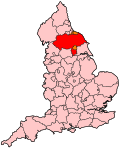York (UK Parliament constituency)
| City of York | |
|---|---|
| Former Borough constituency for the House of Commons |
|

Boundary of City of York in North Yorkshire for the 2005 general election.
|
|

Location of North Yorkshire within England.
|
|
| County | North Yorkshire |
| Major settlements | York |
| 1265–2010 | |
| Number of members | One |
| Replaced by | York Central, York Outer |
The City of York was a constituency represented in the House of Commons of the Parliament of the United Kingdom. It elected one Member of Parliament (MP) by the first past the post system of election.
This constituency covered most of the city of York, though the outer parts of the city and local council area fell within the Selby, Vale of York and Ryedale constituencies.
By virtue of its importance York was regularly represented in Parliament from an early date: it had been required to send delegates to the assembly of 1265, but no actual returns survive until the end of the 13th century.
A borough constituency consisting of the city of York has been represented in every Parliament since the Model Parliament of 1295. Until 1918, it returned two MPs; since then it has returned one. Until 1997, when its official name became City of York with no boundary changes, the constituency was usually simply called York.
Following their review of parliamentary representation in North Yorkshire, the Boundary Commission for England recommended the creation of two new seats for the City of York. Both the City of York and Vale of York seats were abolished in 2010 and replaced by two new constituencies, namely York Central and York Outer.
...
Wikipedia
